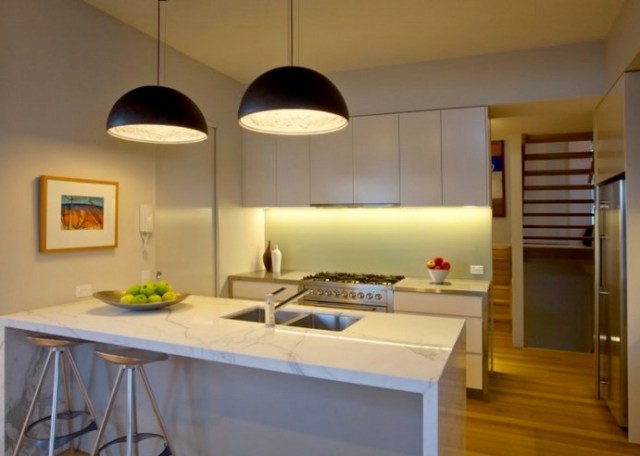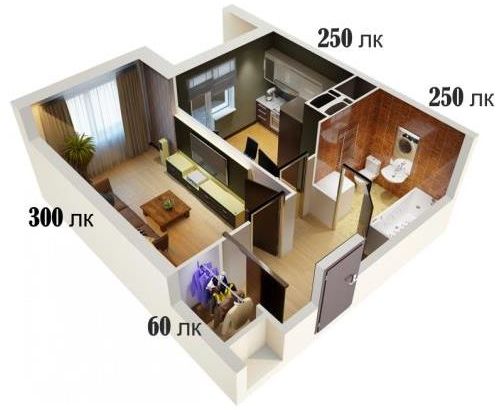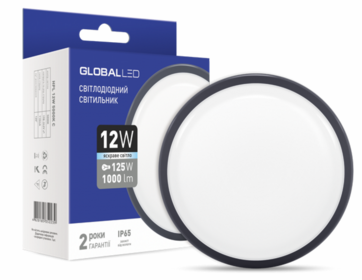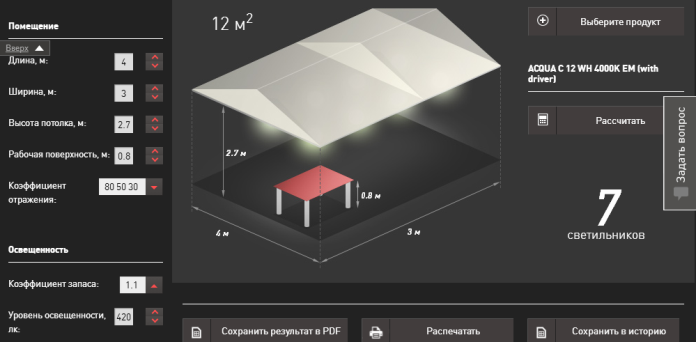Categories: Sources of light, Energy saving
Number of views: 9596
Comments on the article: 0
Calculation of LED lighting of a room in an apartment or house
When repairing an apartment, lighting issues are usually considered without special responsibility, and they install lamps as you like, estimating the brightness of the light "by eye". However, lighting is an important part of any construction, both from a design and from an engineering point of view. Moreover, there are state documents that regulate these issues, such as SNIP 23-05-95 "Natural and artificial lighting."
This article will talk about how to calculate LED lighting for the home. Although the calculations for industrial and other types of premises, as well as using other types of light sources, are generally similar.

Illumination and luminous flux
The purpose of calculations and lighting design is to achieve normalized lighting for a particular room. Each room has its own lighting standard. It can be calculated on the basis of the class of visual work, that is, from how much and with details what size you will work with, what background color on which the part is located, the color of the part itself and other factors.
Usually this scares people far from the topic, but do not worry, we will not delve into such wilds. There are tables with averaged, typical illumination values for each of the types of rooms, so you can use them, one of these tables is given below.
But knowing the necessary lighting is not enough.
Firstly, illumination is the value of the luminous flux per 1 square. m. of illuminated area. It is measured in Lux (Lk). There is also the law of inverse squares, which states that when a light source is removed a certain distance, the illumination of the illuminated surface decreases by a factor of one square. Those. if you raise the table lamp above the table to a height of 2 meters, then the illumination of the table will decrease by 2 squared times or four times.
E = f / s,
where E - illumination, Ф - luminous flux, S illuminated area.
Secondly, in the technical documentation or on the packaging of light sources (lamps, lamps) indicate the value in Lumens (Lm) - this is how the luminous flux is measured.

Types, lighting schemes
Lighting can be artificial and natural. If we can slightly influence natural lighting, then it is easy to artificial. In turn, the artificial is divided into three types, sometimes they say three lighting schemes:
1. General. When the normalized illumination at the height of the working surface is achieved over the area of the entire room. The advantage of this type is that you get a bright light in the whole room, in some cases this can also be a disadvantage.
The disadvantages include the high initial cost, because luminaires and lamps of such power and in such (depending on the area) quantities need to start to buy, maintenance (any lamps burn out sooner or later and need to be changed), as well as the energy consumption of a powerful lighting system.
2. Local. Here, normalized illumination is achieved only by the area of the working surface.
3. Combined. Such a compromise, when the working surfaces are illuminated by local lamps, such as siblings, table lamps and other things, and the aisles, the rest of the spaces of the room are illuminated several times weaker than ceiling lamps (chandeliers, if we talk about the living room).

Lighting calculation
The accuracy of lighting calculations, as usual, depends on their complexity, but in most cases you can use the description below method of calculation of lighting by the coefficient of use of light flux. It is also worth noting that the number of fixtures is affected not only by the luminous flux emitted by them, but also by the shape of the light distribution.
If you argue simply, with a pair of directional light sources you will not achieve uniform illumination, at best you will get a couple of powerful beams of light and scattered light reflected from the walls. But if the lamps give diffused, approximately uniform light in all directions, then you will achieve very easy and uniform illumination.
Suppose that we calculate the lighting of the living room, from the table given at the beginning of the article it can be seen that the normalized illumination should be 450 Lux. For the living room, it is better to use a general lighting scheme, because local overexposure is unlikely to add beauty interiors, and functionality to lighting.
Based on the formula:
E = f / s
Express the necessary luminous flux:
F = e * s
And also we introduce two coefficients, one corrective, related to the height of the ceilings, and the second also corrective, but related to the type of light sources.
If the ceiling height is up to 2.7 meters - then KZ1 = 1, if from 2.7 to 3 - then KZ1 = 1.2. For LED lamps Kz2 = 1.1-1.2, take 1.2, this coefficient provides for a decrease in the luminous flux from LED lamps during their life.
Let's say that our living room is of the following sizes - 3x4m with ceilings 2.7 meters high. Then:
Ф = 450Lk * 12kv.m * 1 * 1.2 = 6480 Lm
That is, we need such a light source to provide a luminous flux of 5400 Lm. At led bulbs the average light output is at the level of 80-120 Lm / W, take averaged 100 lm / W, then we need 54 W of LED light.
At first glance it may seem like a lot, but in fact you can achieve this by installing 5 12-14 W lamps in a chandelier with five horns. But you must admit that in a living room of such sizes, such a chandelier will fit perfectly, and will create a sufficient amount of light.
We gave an example on the first chandelier we came across. However, for the selection of the number of lamps and the number of lamps in them there is another, more technical method.
We take for N - the number of lamps, n - the number of lamps.
To calculate how many lamps with LED lamps you need to place in a room, you need to determine its luminous flux. There are two options.
1. If you will hang up ready-made fixtures where the lamps are not replaced, you need to look at the documentation for it, or find the same in any online store and see its light output, it should also be written on the package. For an example, let's take such mortise luminaires, their declared power is 12W, and the luminous flux is 1000 Lm.


Then: N = Total / Light
N = 6480/1000 = 6.48 luminaires
It is better to round up, then you need to purchase and install 7 LED lights.
2. If you already have a chandelier with several horns, for example with five, then you can calculate the lamps, what power you need to screw into it:
w = Total / (number of horns * 100)
Total is the total luminous flux, which we calculated above - 6480, w - lamp power, 100 - this is the number of Lm / W issued by LEDs
W = 6480/5 * 100 = 12.96
In principle, the power of the lamps coincided, above we roughly indicated 12-14 watts. The calculations are correct.
In the above calculations, we did not take into account the reflection coefficients, these are approximate values that allow us to estimate the approximate amount of light that is needed for the lamps. I purposely omitted this information, on the assumption that it is unlikely that anyone will take the calculation of lighting for the home so seriously, and choosing such a lamp and lamps will help such a calculation.
Automation of lighting calculations
In the 21st century, most of the design work was automated; there are a lot of software for PCs. It is called "computer-aided design systems" or CAD for short.

And there are excellent solutions for lighting, for example, the Dialux program will help to calculate LED and other types of lighting, in addition, it has examples of finished projects, the strength of this program is the visualization of the approximate final result, if you are interested, write in the comments and we will do a detailed review this software. This video demonstrates how to use Dialux.
To check the calculations, you can use the online calculator. There are many on the net.
By the way, our calculations turned out to be quite accurate, and the number of fixtures coincided, I chose similar fixtures by the ones shown in the example.
See also at i.electricianexp.com
:
